
 hree
outstanding artists of Black Boston in the last
century are Lois Mailou Jones (1905-1998),
Allan Crite (1910-) and Meta Vaux Warwick
Fuller (1877-1968). hree
outstanding artists of Black Boston in the last
century are Lois Mailou Jones (1905-1998),
Allan Crite (1910-) and Meta Vaux Warwick
Fuller (1877-1968).
All had distinguished careers and major exhibitions.
Crite and Fuller, working with Maud Cuney Hare's
Allied Art Players, also played a role in the development
of Boston's nascent black theater.
 
Lois Mailou Jones (1905-1998)
was born in Boston and lived with her parents and
brother on School Street, near the Boston Common.
She trained as an artist at the Museum School of
the Museum of Fine Arts.
A life-changing encounter occurred when she returned
from a trip to Paris: she met Alain Locke on the
campus of Howard University. As leader of the New
Negro Renaissance, Locke told her: "'. . .I wish
you would do more with the black subject, Lois Jones.
All of you artists have got to do something about
this movement. You've got to contribute as artists.'"
Jones stated for the record:
"So I took very seriously
what he said, to the extent that I immediately
went back to my studio apartment in Washington
and decided to do a subject which would deal
with lynching because we were having lynchings
ast that time in the '40s"(Oral History, Schlesinger
Library, 16).
That painting was "Mob Victim."
Jones then took up black themes in earnest: examples
are "Negro Youth" (see image below), 1929,
"Ascent of Ethiopia" 1932, and Cubist forms,
"Les Fètiches" 1938.
A s
a child Jones spent summers on Martha's Vineyard
Island, where her family and writer Dorothy West
rented summer houses next to each other in Oak Bluffs. s
a child Jones spent summers on Martha's Vineyard
Island, where her family and writer Dorothy West
rented summer houses next to each other in Oak Bluffs.
Jones' parents later bought a [Methodist] Campground
house and had it "rolled up" School Street to 21
Pacific Avenue, where it still stands. (Martha's
Vineyard Times, June 18, 1998, 2).
Also on the Vineyard, her mother
worked as a maid and ran her own hairdressing business.
Jones began studying art at an early age, encouraged
by her parents.
After Jones finished at the Museum School, fellow
artist Meta Vaux Warwick Fuller advised her
that she should go to Europe, where her race would
not be a barrier to success in art (Oral History).
Jones won a fellowship to the AcadÈmie Julian in
Paris in 1937. She was elated to discover that in
Paris a black woman encountered less prejudice than
at home.
Jones painted impressionistic
landscapes, Cubist- influenced abstractions and
subjects from recent black American history.
In 1930 Jones joined the faculty at Howard University
in Washington DC, retiring forty-seven years later.
Jones was not exempt from racial
incidents, however. In one particular instance,
her well known "Indian Shops, Gay Head, Massachusetts"
won the Robert Woods Bliss Prize for landscape in
1941 at the Corcoran Gallery in Washington, D.C.
But she had to have a friend submit the painting
for her and had to receive the prize by mail, because
the Corcoran at that time did not accept submission
from African American artists.
The Corcoran did, however, celebrate her work in
the last decade of her life (Martha's Vineyard Times,
loc. Cit.).
Jones, an important artist linked
to the trans-Atlantic idea of NÈgritute (CÈsaire
and Senghor), also won the distinction of being
the last surviving artist of the New Negro or
Harlem Renaissance.
For all of her prizes, one
of Jones' proudest moments came early on, when she
had her first one-woman show in her native Boston,
at the respected Vose Galleries on Newbury Street.

The distinguished sculptor Meta
Vaux Warrick Fuller was born in Philadelphia,
and came to Boston after studying in Paris at the
AcadÈmie Colarossi and the Ecole des Beaux Arts.
Rodin proclaimed her "a born sculptor"; Saint-Gaudens
allowed her to work in his own studio.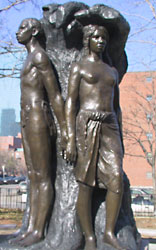
As with Lois Mailou Jones,
a meeting with a famous African American intellectual
led her to a turning point in her artistic career.
W.E.B. Dubois advised Meta to introduce African
and African American themes into her art and to
use art as an expression of the African-American
experience.
Dubois later commissioned Fuller to do a piece to
mark the fiftieth anniversary of the Emancipation
Proclamation.
Fuller's most famous sculpture, "Ethiopia Awakening,"
became symbolic of the rise in Pan-Africanism both
in thepolitical and cultural world."
When Meta Warrick Fuller married
Dr. Solomon Fuller, a distinguished psychiatrist,
the couple settled outside of Boston, in then rural
Framingham, where they raised their sons.
Fuller collaborated with black creative artists
living in Boston proper. Her name appears on the
playbills of the Allied Arts Players, headed
by Maude Cuney-Hare.
Before coming to Boston, Meta
Warrick had already established her reputation.
At thirty years old, fresh from the studios of Paris,
she accepted a commission "to construct in a true
and artistic manner" tableaux "so arranged as to
show . . . the progress of the Negro in America
from the landing at Jamestown to the present time."
Links of Interest:
A
display of the tableaux and a portrait of the
artist from 1907
An
excellent bio-article on Fuller and the scope
of her artistic career

Allan Crite (1910) has
been a life-long Boston artist. 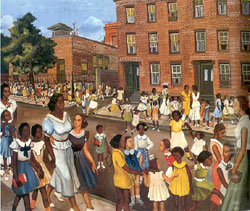
He was just ten months old when
his family moved to the city from Plainfield, New
Jersey. He has never lived anywhere else, though
Dilworth Street, where he lived as a child, was
erased by urban renewal (what Crite calls "urban
destruction").
His paintings, which depict
the Roxbury neighborhood of his youth, are now prized
as historical records for the city of Boston.
Crite's spiritual dimension is expressed in religious
scenes and altar pieces that can be found in chapels
and churches across the country.
Younger than Lois Mailou Jones by five years, Crite
followed her footsteps to the School of the Museum
of Fine Arts Boston (1939). He was one of the few
African American artists to work briefly for the
Federal Arts Project (FAP) in the 1930s.
Links of interest:
A
photograph of Allan Crite and an outline of his
artistic career
A
description of Crite taking a visitor through
his house museum

Beauford Delaney (1902-1979)
was born in Knoxville, Tennessee.
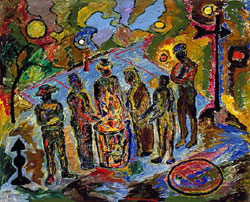 In
1923 he moved to Boston, where he took art classes
at the Massachusetts Normal Art School and the Copley
Art Society and met the poet Countee Cullen
and other intellectuals. In
1923 he moved to Boston, where he took art classes
at the Massachusetts Normal Art School and the Copley
Art Society and met the poet Countee Cullen
and other intellectuals.
This was a formative period of his life. In 1929
he moved to New York City and on to Paris in 1953.
His painting, figurative when abstract art carried
the day, did not at first get its due from art critics
and historians.
In Paris Delaney became fast friends with James
Baldwin, who in 1964 had this to say:
"[Delaney] has been starving
and working all of his life-in Tennessee, in
Boston, in New York, and now in Paris. . .More
than any man I know he has trasncended both the
inner and outer darkness."
Links of Interest:
The
career of Delaney, based on the biography
Amazing Grace: A Life of Beauford Delaney (1998)
by David Adams Leeming.

Though lacking the access to patronage enjoyed by
many white artists of the times, Fuller, Jones,
and Crite were not the first of their race to find
inspiration in the city where Mrs. Isabella Stewart
Gardiner and the Museum of Fine Arts created an
art-loving climate.
Before Fuller, Jones and Crite
came sculptor Edmonia Lewis (1940s-c.1890).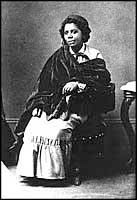
Born in the middle of the 19th
century, part Chippewa Indian, part African-American,
and an orphan, Lewis was educated at Oberlin College.
As a child she roamed the woods with the Chippewas
and Chippewa heritage played a part in her work,
as did the black legacy. Her brother supported her
studies at Oberlin College in Ohio, a major abolitionist
center at the time. Later, in Boston, her desire
to become a sculptor took hold.
The neoclassical sculptor
Edward Brackett mentored her and she created
a medallion portraying the abolitionist leader John
Brown and in 1864 she completed a bust of Robert
Gould Shaw, the Civil War colonel who led an
African American regiment to glory.
From Boston this wanderer went
to Rome, home to many expatriate American artists,
including several women.
In her work she infused elements of her ethnicity
(including elements of Egypt, which she saw as African),
which was not always the case by any means for her
times.
She also used African-American themes in creating
works like "Forever Free," where she celebrates
the emancipation of slaves.
She was the first African-American, man or woman,
to pursue sculpture in great depth.
In Rome, Lewis was welcomed into a tight-knit circle
of American expatriates whose artistry was not confined
to sculpture or to painting, but encompassed acting
as well. Women could succeed in Europe, where they
could not in their own country.
For an African-American woman
Europe represented two-fold salvation. A discussion
of Lewis' career can be found at this
site.
Yet another African American
who made an early appearance on the Boston art scene
was Edward Mitchell Bannister (1828-1901),
born in St. Andrews, New Brunswick, Canada, c. 1828.
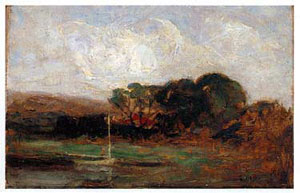 Bannister
migrated to Boston, around 1848. Photographer, daguerrotypist,
1863-1865, and portrait painter, 1863-1872, he moved
to Providence, Rhode Island in 1869. Bannister
migrated to Boston, around 1848. Photographer, daguerrotypist,
1863-1865, and portrait painter, 1863-1872, he moved
to Providence, Rhode Island in 1869.
He received a Bronze Medal in
Art at the Philadelphia Centennial Exhibition, 1876,
and founded the Providence Art Club in 1872.
Bannister served on the Board of Directors of the
Rhode Island School of Design (RISDI) in Providence.
|


